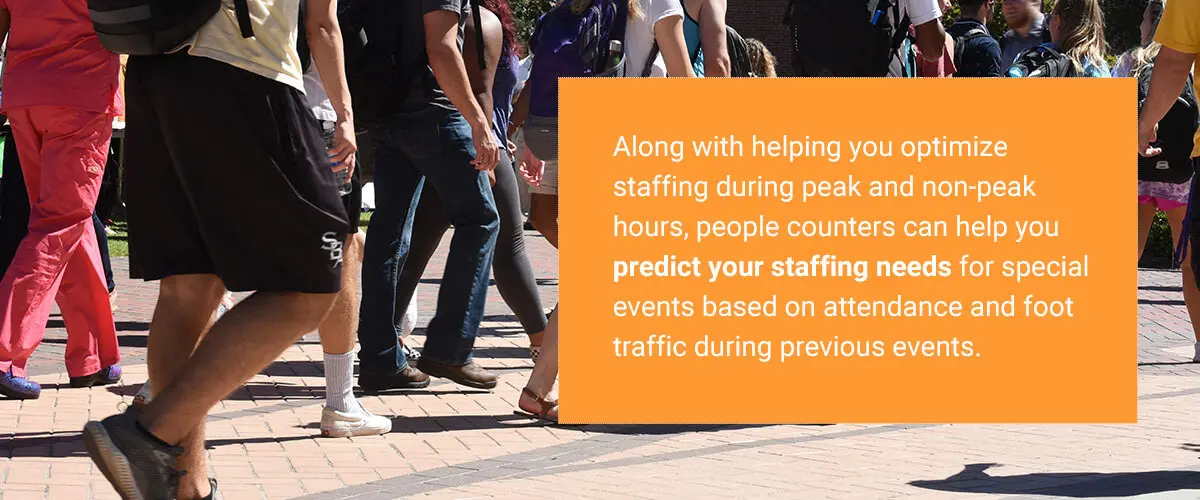
Another benefit of implementing a people counting system on your campus is that you can refine your budgeting techniques and create a better budget, even if you’re facing university budget cuts. This chapter covers how to allocate university funding and how a people counting system can help you determine ideal hours of operation, staffing levels and maintenance. We also cover how people counters can help universities determine how much security is necessary and in what areas.
As budgets grow tighter, universities must use their funds wisely and fight against cuts in funding. Increases in enrollment and decreases in funding can quickly strain your institution’s resources. When you face budget cuts, the solution is not as simple as merely increasing tuition, as students and parents will expect improvements to your campus when tuition increases.
To attract and engage first-year students and retain existing students, campus buildings should run efficiently. When you have the knowledge you need to operate a building at optimal efficiency, you can reduce personnel and operation hours during slow hours and augment these factors when the building is busy. This means your university can spend only what is needed and avoid overcompensating.
People counter data can show when areas are at peak hours and when they experience the lowest traffic. Rather than relying on estimations, you can use people counters to determine operating hours based on the data about when visitors are entering or exiting a building. This can help determine if those areas can be closed at certain times of the day or if they should be open longer, both of which can help you combat funding getting cut.
Facility management can be costly for your university, so it’s essential not to spend money to keep a facility open when it isn’t likely to be used. This is an area of waste that can be easy to overlook, which is why people counters are so useful if your budget has been slashed. Data from a people counting system can help identify areas of waste so staffing and equipment for your facilities stay within your budget.
Additionally, people counters can help you determine where to funnel more money to keep facilities open longer and during peak hours. Knowing which areas of your campus receive the most foot traffic tells you where to allocate funds, such as the cafeteria, the fitness center or the student union.
For example, in the student union, you may have multiple floors and rooms, so it can be difficult to determine when an area is used and for how long. When you install a sensor over the hallways and doors, those people counters can easily track trends in building usage and provide hourly foot traffic counts that let you know when to open or close a building, floor or room.
Similarly, if an area can’t be closed completely, staffing can be reduced during dead hours and increased during peak hours. Once you are aware of the ideal hours of operation, you can optimize staff schedules as well. Schedule more staff members during peak hours to avoid lines and frustration.
Many universities and colleges cannot consistently pay multiple employees to cover the same shift, and when you optimize staffing in each of your campus buildings, you won’t have to. During off-peak hours, you can reduce staff to save money and avoid unnecessary overstaffing. University budgets can be limited, so it’s important to use your funds wisely.

Lastly, if a building sees a lot of use, it may require more maintenance. You can use people counters in your facilities to estimate the resources needed, and with foot traffic data, you can show how many students and faculty are using the building to justify your requests for additional food vendors, cleaning supplies and maintenance staff.
Additionally, knowing on and off hours will help determine when cleaning staff will have the easiest time cleaning the space. You can also better direct maintenance workers to areas that tend to require more attention when you can pinpoint high-traffic areas in a facility. This ensures these areas will be cleaned more often and remain sanitary for visitors.
Along with helping you optimize staffing during peak and non-peak hours, people counters can help you predict your staffing needs for special events based on attendance and foot traffic during previous events. You can use people counters to estimate staffing needs for any day, week or month. You can even determine how many employees you need in a given semester or year.
People counters can also help your university or college campus determine how much security is necessary and in what areas. When you understand what foot traffic is like on your campus, you can hone your strategy for security staffing and identify the optimal ratio of security personnel to students. With valuable data from people counters, you can avoid overpaying and overstaffing and better protect students and faculty with the proper levels of security. You can also fight against funding getting cut by not overpaying and reducing costs where possible.
By placing security personnel strategically, you can deter criminal activity on your college campus. With people counters, you may find that security staff should frequently stop by specific areas of campus. Other locations may only require occasional stops. Regularly review your people counter data regarding foot traffic and crime to optimize your strategy for security staffing and the routes that need the most protection and coverage. Get a people counting system for your university from Traf-Sys to optimize security, maintenance, staffing and hours of operation.